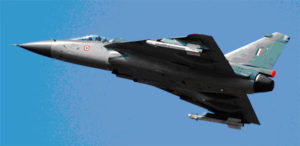LCA Tejas Fighters Give Big Boost To Indian Air Force’s Strike Capabilities
December 17, 2021
The state-run Hindustan Aeronautics Limited (HAL) has given a giant leap to India’s flagship initiative ‘Atmanirbhar Bharat’ or Self Reliant India which aims at bringing greater indigenization in defense manufacturing.
On December 16, 2021, HAL signed a deal with Bharat Electronics Limited for the development and supply of 20 types of systems for the Tejas Mk1A light combat aircraft (LCA) program.
The Bengaluru-based HAL said in a statement that a five-year deal, which runs from 2023 to 2028, entails supplying crucial avionics Line Replaceable Units (LRUs), Flight Control Computers, and Night Flying LRUs in what is called the biggest ever order that the state-run company has placed on any Indian company boosting ‘Atmanirbhar Bharat’ campaign.
“The LCA Tejas program is a great example of collaboration between Indian defense institutes like HAL, DRDO, and BEL. The latest order for the development and supply of 20 essential avionics LRUs for the Tejas Mk1A is a boost for Make in India”, said R. Madhavan, the chairman of HAL.
The order for these systems meant for the 83 Tejas Mk1A fighter fleet will be fulfilled by two divisions of BEL at Bengaluru and Panchkula (Haryana). According to the statement, BEL will deliver all of the contracted equipment to HAL in a ready-to-board condition.
In February this year, HAL was awarded the contract to manufacture 83 LCA for the Indian Air Force (IAF) at an estimated cost of Rs 48,000 crore at the 13th edition of Aero India in Bengaluru.
Deliveries to the IAF will begin in 2023 and end in 2024. The indigenous fighter will be outfitted with a locally-developed flight control computer and an air data computer, both of which will be provided by BEL under this deal. DRDO and Bengaluru’s Aeronautical Development Agency have collaborated to develop both of these systems.

HAL contract signing ceremony with BEL
India has been making concerted attempts to boost the capability of its armed forces as the country faces what is seen as two-front war threats from China and Pakistan. In fact, the existing Tejas in the IAF fleet had earlier been deployed along the Western border in August last year amid tensions with China.
So while the more superior fighters in the IAF fleet were flying around, over and near the Eastern Ladakh sectors, the light combat planes had assumed the role of a watchdog against Pakistan along the Western region.
Tejas To Get More Teeth
India has been attempting to develop a variety of indigenous technology and weapon systems in order to increase defense sector self-reliance, especially for its LCA Tejas.
HAL had signed a $716 million deal with American company GE Aviation earlier this year for 99 F404 aircraft engines and related services to power the indigenous Tejas LCA Mk-1A. On top of that, it is now building its own indigenous engine that is expected to power its Tejas variants as well as its AMCA aircraft.
The development of a homegrown AESA radar, which will be installed in the Tejas, is a big step forward and is aimed at creating a balance of power with China, which too has the AESA radars, as previously reported by the EurAsian Times.

HAL Tejas
These AESA radars will be installed in all 83 Mk1A Tejas Aircraft which will boost its capability significantly. These radars, like the current avionic systems, are also largely indigenous with about 95% local component.
Additionally, India is also procuring HAMMER missiles from France to integrate them with the LCA Tejas aircraft after its success with the Rafales.
They are being procured under the emergency route granted to the military in the backdrop of continuing Chinese aggression. These missiles are expected to enhance the firepower of these LCAs and allow them to strike bunker targets deep inside the enemy territory.
LCA Tejas MK-1
The 83 Mk-1A planes brought the total number of LCA versions ordered to 123. The 40 LCAs that the IAF has already ordered are in the initial operational clearance (IOC) and advanced operational clearance (FOC) variants. The LCA Mk-1A will have a number of enhancements over the FOC aircraft, making it the most advanced LCA variant to date.
The Mk-1A variant includes digital radar warning receivers, external self-protection jammer pods, AESA radar, enhanced beyond-visual-range (BVR) missiles, and greatly better maintainability. The indigenous component of the fighter is estimated to be around 60%, compared to 50% in earlier models.
After completing the requisite design efforts, HAL has set a March 2022 timeline for the first flight of the LCA (light combat aircraft) Mk-1A fighter, according to HAL chairman R Madhavan.
Madhavan had said earlier that the countries in Southeast Asia and West Asia were showing interest in the Light Combat Aircraft (LCA) Tejas, and that each LCA MK1A jet would cost a total of Rs 306 crore.
The LCA Tejas and its two variants in the pipeline have become the flag-bearers of India’s indigenous defense manufacturing. The new HAL contract is expected to not only give the requisite push to self-reliance but also boost the capability of the Tejas which is now being pitched to friendly countries.
Courtesy: Eurasian Times

